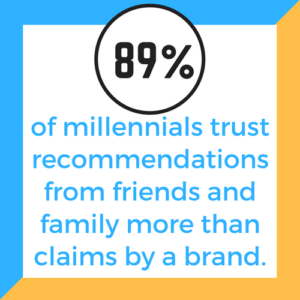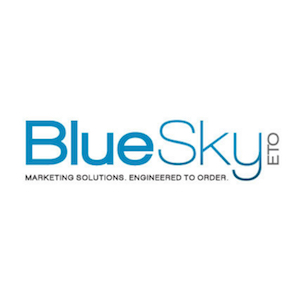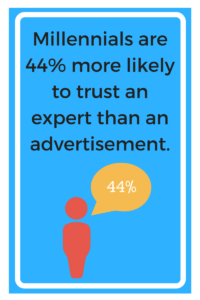“There’s a massive shift in consumer behavior and consumer trust,” says Rick Yang of New Enterprise Associates, one of the world’s oldest venture-capital firms. “I think coming out of [the financial crisis], millennials have a massive distrust of existing financial services. They tend to trust technology more than the recognized brands, like a JPMorgan Chase or a Wells Fargo.”
In other words, new financial service providers and tech startups are gaining traction in the millennial market. Major brands are struggling to keep up. To build brand trust, banks need a modernized marketing strategy to reach this coveted audience. We dove into market research and spoke with financial marketing experts to discover that building brand trust may be an uphill battle for banks, but it IS possible if marketers follow these key practices:
 Position Advisors as Financial Experts
Position Advisors as Financial Experts
Millennials are 44% more likely to trust an expert than an advertisement. They’re also 247% more likely to be influenced by social media and blogs. Put these facts together and you’ll see why influencer marketing is more popular than ever. Today, you can’t scroll through Instagram without seeing at least one celebrity or social star posing with a detox tea or protein shake. Financial service marketing can’t exactly take the same approach. However, the concept of influencer marketing can provide some leverage for banks.
The trick is to turn financial advisors into brand ambassadors. Millennials need advice on paying down loan debt and budgeting for their future. Financial advisors can provide solutions through content like blog posts, interviews on major financial sites, and even quick budgeting tips shared on social media. Content from brand ambassadors helps with building brand trust by humanizing a bank in a way traditional advertising simply can’t.
Building Brand Trust Through Diverse Offerings
Members of the millennial generation were born between 1982 and 2004. That 22-year age gap is a big one. A teenager applying to college has different financial needs than a mom in her mid-thirties. However, too many brands lump them both together, sprinkle emojis all over an ad and hope for the best.
Millennial marketing needs to be diverse, because millennials are diverse. They’re also proactive. Only 33% of consumers over 55 say they’re interested in financial management tools from banks. With millennials, that number climbs to 67%. Millennials are also set to inherit $30 trillion in the next 30 to 40 years. So not only are their financial goals diverse now, but we can expect them to change as they mature.
Instead of focusing all millennial marketing around a single product or service, banks should take their own advice and diversify. Then continually use A/B testing to measure which campaigns resonate with millennials most. Spend time researching and developing separate brand personas within the millennial demographic. This will make strategic targeting much easier.
Building Brand Trust Through Activism

Think of the shoe company TOMS. The company began on a one-for-one premise. Each time someone purchased a pair of TOMS, the company would give a pair to a child in need. To date, over 60 million children have received free shoes as a result. The brilliant marketing strategy was especially popular with millennials, and it’s easy to see why.
The campaign had a clear story. It emphasized a human connection. Consumers could see the faces of smiling children holding their new shoes in print ads and social media posts. The causal connection was clear—if I buy these shoes, I will help one child. More than that, TOMS could be worn as a badge of honor among socially conscious millennials.
Building brand trust with millennials is easy with cause marketing that:
- Tells a story that creates a human connection with those in need.
- Breaks down the impact of the cause to show how it helps each individual person.
- Turns consumers into activists who feel like their actions have made a difference.
- Allows millennials to share visible proof of giving back.
- Demonstrates their commitment to local communities.
Whichever form cause marketing takes, banks need to remember that you can’t build trust without transparency. The more unique and transparent a cause marketing campaign is, the more useful it’ll be in attracting millennials.
Transparent Millennial Marketing for Bank Brands

- Inherently distrustful of lenders.
- Living on tight budgets which could be heavily impacted by unexpected fees and charges.
- In need of additional loans for homes, cars, home repairs and more.
To build brand trust with these consumers, transparency is key. This doesn’t mean including five pages of fine print with every contract. True transparency requires personalized interaction. Financial advisors and other bank employees need to spend time with consumers to uncover their needs, address their concerns and fully, completely, and at times exhaustively, explain lending practices before they sign on the dotted line. If your bank is producing inbound marketing content, you should be addressing these concerns for your millennial customers.
Each minute spent on transparency is an investment. A consumer who feels they can fully trust their bank becomes a member for life.
Building Brand Trust Through Employee Engagement
The marketing world has become increasingly focused on building a positive reputation, brand trust and most importantly authenticity. The way that brands approach social media towards millennials in particular has become more casual and personal. “Millennials are interested in information from real people, says PR Specialist Perry Betts. “That’s why an employee advocacy tool, like Smarp, helps for Humanizing Brands™.”
“Millennials look for positive interactions and engagement from social media channels, not just content being pushed at them. Having employees participate in the brand’s communication has been proven to receive 8 times more engagement and reach 10 times more people than if shared on the brand channel alone.”
The benefits are clear, but there’s no need to give every bank teller access to the corporate Twitter account. Banks can build trust by simply encouraging employees to share social posts. Create Facebook events for fundraisers, community events and special promotions. Encourage employees to invite friends. Give branch managers the ability to customize social media images with the help of Marketing Templates. Employee engagement doesn’t have to put brand compliance at risk!
Building Brand Trust Through Reviews
Did you know that 89% of millennials trust recommendations from friends and family more than claims by a brand?

“User-generated content is a very important tool for building brand trust with millennials. Millennials like to know that their peers recommended a product before they buy it. So brands should try to leverage reviews of products left on websites like Amazon or Trustpilot.”
Golinski recommends publicizing good reviews. This could mean retweeting a comment about a bank’s great customer service. It could also mean sharing testimonials on a dedicated page of the bank’s website. “Your website and social media channels should be full of user-generated content that will make other millennials want to learn more,” says Golinski. Turning happy customers into brand advocates is one of the best ways to build trust.
Emphasize Entertainment on Social Media
Rachel Stephens, SEO and Customer Behavior Analyst for Totally Promotional, says banks need to target their marketing strategy on social platforms.
“Don’t advertise on social media the same way that you would on a billboard. Social media is more about connecting with your customers rather than selling to them. Millennials are not on social media to shop. They are there mostly for entertainment. So if you can entertain your target audience and not annoy them on social media, your brand will be top of mind when they are ready to buy.”
Remember, “entertaining” doesn’t always mean funny. An infographic sharing financial statistics can be entertaining. Photos from a recent fundraiser can be too. Building brand trust can be as simple as asking, “Would I click on this?” before each post.
Millennial Marketing Should Always Add Value
Consider this quote from Forbes contributor Patrick Spenner:
“Beyond just being innovative and useful, the brands that give Millennials a reason to engage, whether that’s branded content like what Intel has produced, or creating an experience that they couldn’t have without the brand, like many of Red Bull’s events, have figured out how to connect to this generation in a meaningful way. These brands know how to provide what matters most to Millennials in a way that is additive to their lives and entertaining, which in turn compels them to share their experiences with their friends.”
Many financial brands struggle with building brand trust among millennials because all of their marketing is seen as “pushing” a product or service.
“The biggest mistake that marketers make when trying to attract millennials is forgetting to balance their promotional content with value-adding content,” says Zellie Friedman, Social Media Manager for Power Digital Marketing.
“Millennials despise the feeling of ‘being sold to.’ They can easily see through a forced call-to-action. To build brand trust, banks need to make more deposits than withdraws in their social content, meaning non-promotional content should far outweigh traffic-driving posts.”
The Biggest Millennial Marketing Mistakes
The road to marketing failure is paved with good intentions. As companies struggle to capture the imagination of an entire generation, many miss the mark. Here are a few of the most common mistakes companies make with millennial marketing:
1. Stuffing Millennials Into a Single Silo
The term “millennial” refers to someone who was born between 1982 and 2004. Should your marketing strategy be the same for a 14-year-old as it is for a 35-year-old? Of course not. Beyond age, millennials are incredibly diverse in race, income, and even hobbies and interests. It’s a big mistake to assume one approach will woo them all.
“Instead, brands should be talking about gardeners with Snapchat or Pinterest accounts,” says Joel Windels at Brandwatch. “Or people that own tablets that also like NFL. Or people that drink soda twice a day and live in New England. There’s so much more nuance and potency in targeting at this level of granularity than sweeping terms like Millennials, Generation Y or Baby Boomers can ever offer.”
Send highly-targeted messages to niche audiences automatically.
2. Trying to Build Trust While Trend-Hopping
“A mistake brands often make when trying to win over millennials is jumping on any trend,” says Rachel Stephens.
A trending hashtag or video challenge may seem tempting, but does it reflect your brand values? Will posting that meme help you truly connect to your customers, or will you come across as out-of-touch and pandering? When in doubt, take Stephen’s advice: “Don’t try to be overly trendy—stay true to your brand image.”
3. Spreading Marketing Strategy Thin on Social Media
Heather Cosson, Inbound Marketing Specialist for Communications at Syracuse University, says bank brands should rethink their social strategy.
“One of the biggest mistakes companies make when marketing to millennials is jumping on a new social platform without a clear strategy,” says Cosson. “Before you start marketing on a new platform, research your audience. Is your audience on this platform? How are they using it? What do you have to say on this channel that would be of value to your audience? What type of content will you share and how often? Until you know the answer to these questions, you should not be marketing on a new platform.”
4. Trying to Speak the Lingo
If financial marketers know about a cool new term all the teens are using, trust us—it’s not cool anymore. So stop dabbing, stop saying things are “on fleek” and don’t you dare claim “it’s lit” at the bank branch today.
There’s a 100% chance that using new slang terms will make your brand seem like an out of touch dad. We’re guessing that’s not the brand image you’re going for. “It’s like the high school guidance counselor trying to be cool with the teens,” says Kenneth Burke, Marketing Director for Text Request. “It almost always ends in backlash.”
5. Targeting for Targeting’s Sake
Google returns over four million results for “millennial marketing.” Log onto a business blog or listen to a sales podcast and you’ll see millennials discussed time and time again. With the constant focus on the millennial marketing, many businesses feel pressured to pitch their products and services to this generation. But are millennials really the best targets for every offer? Not always.
For an effective marketing strategy that focuses on revenue, financial marketers should focus their time and money where it’ll have the biggest impact. Take time to research and analyze results of campaigns. If the ROI grass is greener on the other side of 35, don’t be afraid to hop the fence.
As technology changes and culture changes with it, the way we interact with brands will evolve. That goes double for tech-savvy millennials. So financial marketing solutions need to remain nimble. Marketers need to measure campaign engagement and connect with millennials to analyze their efforts. For the latest trends and expert insights, subscribe to the BlueSky ETO Brand Management Blog.
Want to give your millennial marketing campaign an edge?
Fintech Marketing Strategy: 10 Ways to Build Your Financial Brand
Financial services marketing has traditionally been a somewhat bland business offering—at least as far as consumers are concerned. But that's exactly why modern-day marketing tactics have had to adapt—to meet people's ever-changing needs. Fintech answers that call in...
Credit Union Marketing Compliance: What You Need to Know
Marketing in the financial services industry is a highly-regulated practice. So, when credit unions prepare to advertise their products and services, they're faced with some important questions—regardless of the marketing channel they use. What advertising disclosures...
Insurance Marketing Solutions: The Best Software for Distributed Teams
If your insurance business has multiple locations and remote employees, it can be difficult to get everyone on the same page. That's especially true when it comes to your marketing messages and materials. Brand management software helps insurance marketers. You'll...




 Position Advisors as Financial Experts
Position Advisors as Financial Experts




I think building brand trust can go a long way with every generation. Each will have its own intricacies, but it’s important to adapt.
I definitely agree that millennial marketing should add value and I think that branded merchandise is another way of marketing that wasn’t touched on in this article https://www.wholesalelanyards.com/ offers a wide variety of options for large businesses as well as consumers we use them at my company and I appreciate the little things.
This is very interesting . I never knew that generation has a distrust for the banking industry
Honestly, I tend to prefer credit unions over large banks. Credit unions seem to put more care and consideration into their customer service.
This is very interesting. As a human resource professional just about everything we do requires a different perspective for millenials.
This is great for the younger ones. They really need to install this in HS education because it is hard to get to them as they wander off in life
This is great info! We always go with banks that gives the best rate and returns.
I think it is hard now a days to get the trust of anyone. I just was in the bank opening a new account and I was not thrilled at how much I had to leave in both savings and checkings. You do have great ideas to gain trust.
This is a very well written post with very relevant information. I as a “millennial” don’t trust the banks either. Not sure anything they target me with will change my mind, but I don’t feel they have properly tried either.
I would ever even have thought about this but i guess that’s exactly what the big companies have to consider, really interesting!
Interesting read for sure. The world is certainly changing but I have stuck with the same bank forever. Mostly because I tend to think they are all the same and equally as terrible!
I am using the same bank I used when I was a kid. I like small local banks 🙂
I tend to choose the bank with the best rates. Millenials may have different needs.
This is a really interesting post, it is amazing to see how with each generation you need to change the approach and make it work better for them.